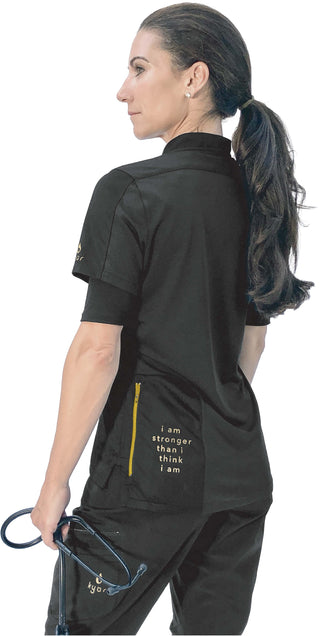The detrimental aspects of pollution through manufacturing processes, microplastics, and the carbon footprint of the fast fashion industry are pressing concerns that extend beyond consumer apparel into specialized sectors like medical scrubs. The fast fashion industry, known for its rapid production cycles and low-cost garments, contributes significantly to environmental degradation. This sector is notorious for high levels of resource consumption, greenhouse gas emissions, and pollution from chemical runoff and waste disposal.
The Staggering Stats
The fast fashion model encourages frequent turnover of garments, promoting a culture of disposability and contributing to landfill accumulation. A 2022 study done by Boston University, stated that an estimated 34 billion pounds of unwanted clothing and textiles end up in U.S landfills each year. Almost 60% of all clothing is made from synthetic fibers which can take up to 500 years to decompose. Divided across the population, that’s more than 100 pounds per person, per year. The short lifespan of low-quality scrubs exacerbates this issue, requiring more frequent replacements and perpetuating the cycle of resource depletion and waste generation.
Understanding the Issue of Traditional Thinking
Many of today's medical scrub brands, while essential for healthcare professionals, often operate within the same unsustainable practices as the wider fashion industry. The focus on cost-efficiency and quick turnover leads to compromises in material durability and environmental impact. The obstacle is traditional thinking; today scrubs are designed, manufactured, and purchased as throw-away items. As a result, the healthcare sector inadvertently contributes to pollution through its purchasing decisions and consumption patterns, despite the critical role scrubs play in infection control and patient care.
Addressing these issues requires a paradigm shift towards sustainable practices in medical apparel manufacturing. This includes prioritizing eco-friendly materials and designing durable scrubs that withstand frequent use and washing can also extend product lifespan, reducing overall waste and environmental impact.
Investing in New Thinking
When I started Kyūr, one of my missions was to introduce a new way of thinking about delivering high performance medical apparel to market. This started with scientifically engineering our collections to discover how advanced materials and meticulous craftsmanship can redefine comfort and functionality in medical apparel. We opted to source our fabrics in the US and make our products in Honduras at a one-hundred-year-old men’s suiting and shirting factory. Lowering our carbon footprint and shortening our delivery time from source to customer. Visit our website (https://kyurmd.com/pages/technology) and learn about our innovative scrubs designed to meet the exacting standards of today's healthcare professionals. For inquiries or personalized assistance, please contact us through our website.
Kyūr is setting a new benchmark in medical scrubs, blending performance-driven design with sustainable manufacturing practices. Join us in embracing the future of high-performance medical apparel and experience the difference today.

